What You Need to Know
- Reverse mortgages can provide monthly tax-free payments to retirees.
- Kotlikoff was skeptical of reverse mortgages but now likens them to an annuity.
- While these loans can have high costs, and unscrupulous lenders are a risk, reverse mortgages come with protections that other loans don't.
Reverse mortgages are a controversial source of retirement cash flow. The loans come with high fees, can place a burden on heirs and can be a vehicle for unscrupulous lenders to defraud seniors.
But others liken it to an annuity that provides free rent long after the house is paid off. This group includes economist Larry Kotlikoff, who was a guest on a recent webinar discussing reverse mortgages.
A onetime opponent, he now has changed his mind.
“I was always very skeptical, probably because [RMs] seemed complicated and I always worried about the issue of people having to move and having to pay back what I thought was going to be a big bill,” Kotlikoff said in the webinar. “[However] the median home equity of people 65 and older is about $150,000 [and] that’s a big number compared to their net worth.”
With a RM, that “trapped” home equity can be utilized.
Morningstar’s director of retirement research, David Blanchett, was equally positive: “Conceptually, they (obviously) make a lot of sense,” he told ThinkAdvisor in an email. “The home is one of the largest assets for many retirees, and therefore being able to utilize that asset to fund retirement spending is something that should be considered, especially since it enables the retiree to live in the house” for the rest of their life.
Only about 3% of retirees currently use reverse mortgages and 5% plan to in the future, making them the least common source of retirement income, Blanchett says, citing the Society of Actuaries 2015 Risks and Process of Retirement Survey. (Those numbers barely budged in the 2019 survey.)
Pros and Cons
To do an RM, clients must be 62 or older and have 50% equity in their home (for a government-protected RM). Yet they still own their home, and they must pay taxes, insurance and upkeep on the home.
Tom Dickson of Financial Experts Network, who hosted the webinar, pointed out some other positive RM aspects.
- An RM allows a client to convert that home equity, or “trapped equity,” into tax-free cash.
- The most popular form of RMs (99%) are those backed by federal government. For couples, only one partner must be 62 or older to qualify. Those age 60 and older can qualify for proprietary reverse mortgages (or jumbo RMs).
- Single-family homes, condos, townhomes and 2-4 unit apartment buildings (with owner occupying one unit) are eligible. The home must be a primary residence.
- No monthly payment is required.
- This is the only residential loan that comes with non-recourse protection, usually a factor in commercial loans. For example, a couple lives in a home until they die. When their heirs sell the home for more than what it costs to pay off the RM, they keep the proceeds of the sale. If the RM is larger than what they can sell home for, the heirs (or even homeowners if still living) would not be responsible for making up that deficit — that’s where the Federal Housing Administration comes in.
Also, RMs come with some safeguards:
1) If the client wants to repay the loan at any time, there is no additional cost;









 March 30, 2021 at 01:07 PM
March 30, 2021 at 01:07 PM











